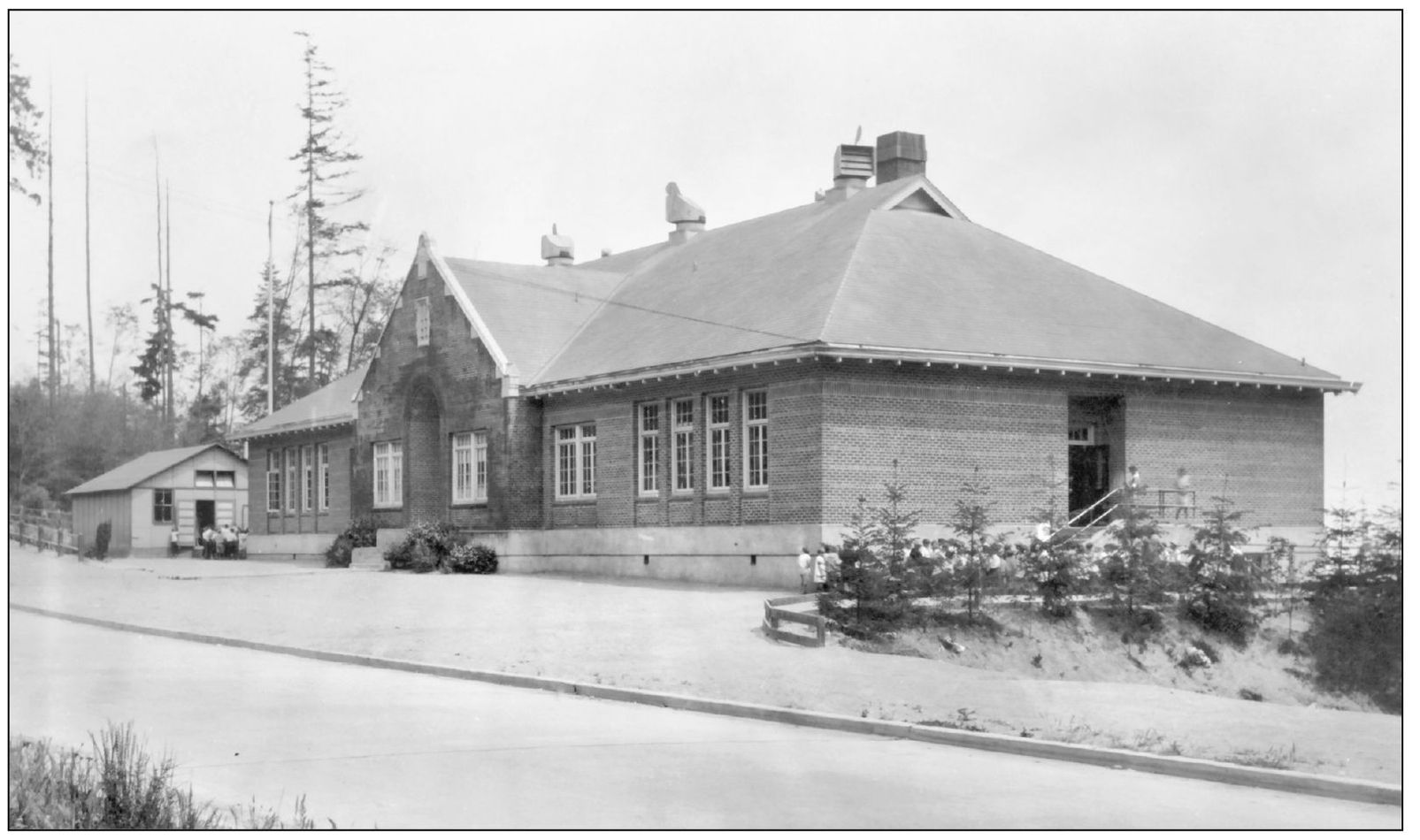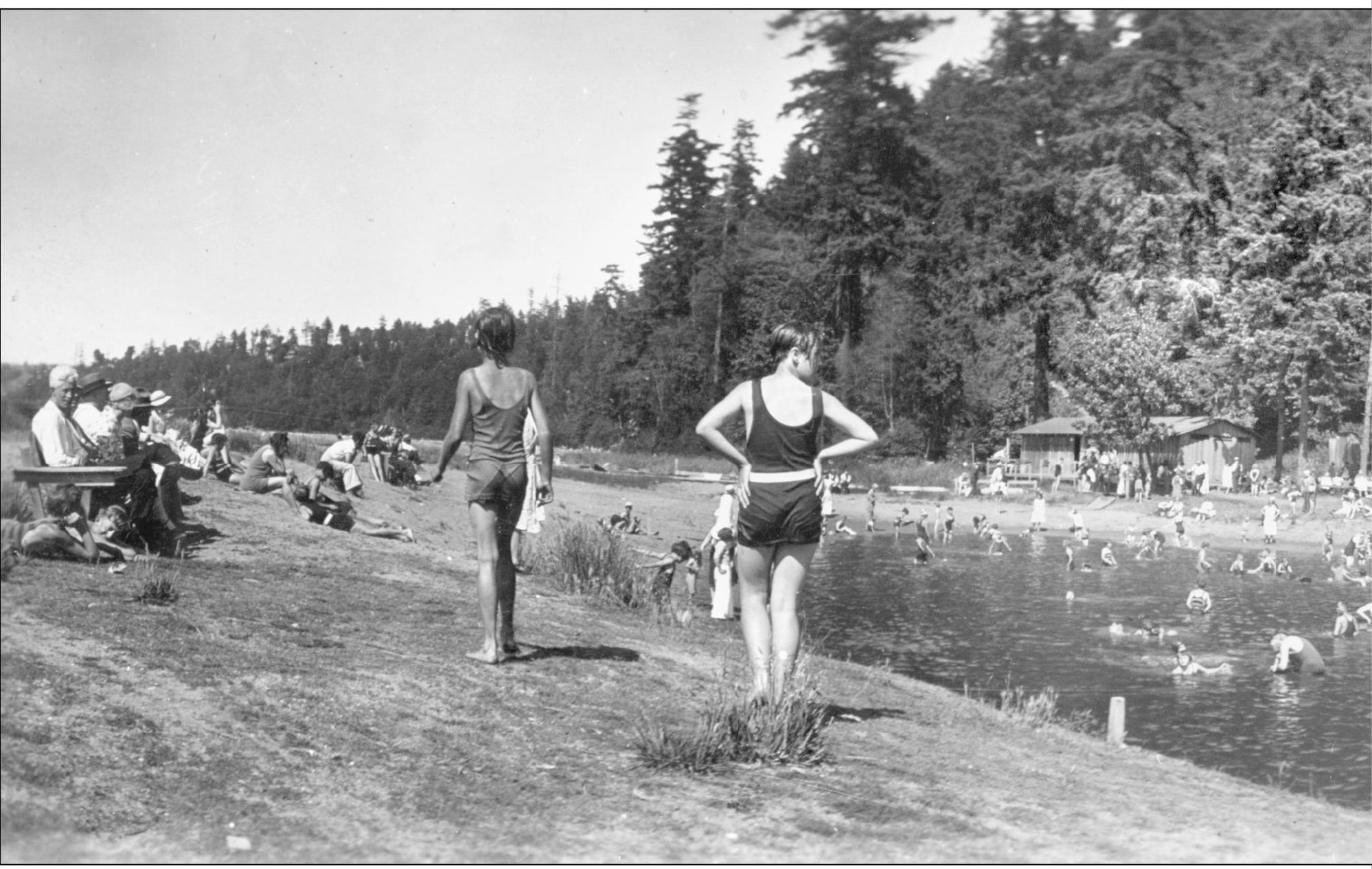Five
FAUNTLEROY

The Fauntleroy neighborhood rests along Puget Sound’s Fauntleroy Cove in Seattle’s southwest corner. Nowadays a strong community of residents and a key transportation link by ferry to both Kitsap County and Vashon Island, in earlier times it was only easily accessed by steamship or canoe. The present name was acquired in 1857 when the United States Coast and Geodetic Survey ship R. H. Fauntleroy and crew explored Puget Sound. The captain had named his ship after the father of his fiance, and Fauntleroy Cove after the woman herself: Ellinor Fauntleroy. By the 1880s, farming began at Brace Point and land clearing and logging occurred throughout the Westside. By the time the West Seattle streetcar extended a line southward to Endolyne in 1907, Fauntleroy real estate boomed. Soon permanent homes began replacing shoreline summer cabins and tents and with them, the permanent community began. Within 10 years, key elements of Fauntleroy were in place: Fauntleroy Community Church, the Kenney, Fauntleroy Elementary School, the ferry dock, and Lincoln Park.

This is the 1901 platform tent housing, located on the north side of Fauntleroy Cove where Lincoln Park is today. As with Alki Beach and Beach Drive SW, early Fauntleroy was a beach vacation spot for visitors from the city. The area also supported farms and logging.

John Adams also set up the first tent store and restaurant on SW Rose Street around 1906. He then began to promote the idea of adding a streetcar line to the isolated Fauntleroy area. On February 15, 1907, the Seattle Electric Company started streetcar service between downtown Seattle and Fauntleroy. Later that same year, the California Avenue SW line was connected to the Fauntleroy line. (Courtesy University of Washington, Special Collections 4627.)

People at Fauntleroy Cove sit under a maple tree enjoying views of the Puget Sound by a dock at SW Roxbury Street around 1905. During the early part of the 20th century, there were at least three docks at Fauntleroy Cove. Only the Fauntleroy Ferry Dock remains today. (Courtesy University of Washington, Special Collections 4631.)

People are dressed in formal attire, enjoying the Fauntleroy Cove beach around 1910. They are wading in the water and looking for seashells on the beach. Cabins can be seen in the background.

Workers are clearing trees in the area of SW Rose Street and Fauntleroy Way SW around 1906. For landowners, the first step was often clearing trees and selling the timber. The cleared land was then sold to home builders. In 1907, West Seattle began to grow thanks in part to the convenience of a streetcar line and new roads. (Courtesy University of Washington Libraries, Special Collections 4625.)

The SW Rose Street grading project, seen here around 1910, shows contractor N. McKinnon using 50 horses to grade the land between California Avenue SW and Fauntleroy Way SW. The street regrading allowed for the development of new home sites in the area.

In 1907, Fauntleroy Avenue, now Fauntleroy Way SW, was graded for the first streetcar. This photograph shows construction near the Fauntleroy Ferry Dock. The high ground on the right, overlooking the construction, is known today as Captain’s Park, and the houses in the picture are still there. (Courtesy University of Washington Libraries, Special Collections 4629.)

The Fauntleroy Community Church is a part of the early Fauntleroy neighborhood center along with the school and business block. In 1908, volunteers built the original church on land donated by John Adams. It was known as “the church built in a day.” In 1914, a gymnasium was added, and a bell tower followed three years later. By 1924, the attached community center became a Seattle YMCA branch. (Courtesy Fauntleroy Community Church UCC and Francis Adams Burke.)

Fauntleroy Grade School, at 9131 California Avenue SW, is shown in 1945. It was constructed in 1917–1918 for first through fourth grades. Because of rising attendance, it was expanded in 1949 and again in 1952. The school closed in 1981, and the Seattle School District leased the building to the Fauntleroy Community Service Agency. With help from the city and state, the agency purchased the building in 2010. (Courtesy Seattle Public Schools, 224-1.)

In 1950, sixty acres of the wooded Fauntleroy hillside was transitioned to housing. Over the next five years, the Arthur C. Webb Company built more than 250 homes, many utilizing the skills of Latvian brick masons. The Fauntlee Hills neighborhood is comprised of more than 250 homes near SW Barton Street and Fauntleroy Way SW.

Workers from the Civil Works Administration (CWA) are building the seawall at Lincoln Park in 1933. Lincoln Park was acquired by the city in 1922. In 1931, workers from Seattle’s Unemployed Fund built a seawall using boulders retrieved from the beach. In 1933, through the state’s emergency employment program and CWA, 260 men worked on the park to build shelters, trails, and tennis courts, in addition to the seawall. (Courtesy Seattle Municipal Archives, No. 29709.)

The West Seattle Commercial Club, now known as the West Seattle Chamber of Commerce, holds a picnic at Colman Pool in 1947. The Lincoln Park saltwater pool became a popular meeting place for community organizations. (Courtesy MOHAI, PI 21620.)

Swimmers of all ages enjoy the Lincoln Park Pool in 1933. It was dredged out on the site of a natural lagoon at Point Williams in 1925. It was 80 by 100 feet, with a springboard for diving at the deep end. A pipe with a gated valve allowed old water to flow out at low tide and new water to flow in at high tide. (Courtesy Seattle Municipal Archives, No. 29770.)


In 1941, the Colman family funded a new saltwater pool to replace the Lincoln Park Pool. It is still in operation today. (Courtesy Seattle Municipal Archives, No. 29735.)

The streetcar line and wooden plank sidewalk are shown looking east at SW Myrtle Street and Fauntleroy Way SW around 1922. The top left corner of the photograph shows the Gatewood School addition under construction.

The Kenney Presbyterian Home for the Aged opened in rural West Seattle in 1909, designed as a replica of Philadelphia’s Independence Hall. As the Kenney Home expanded to add other buildings, this structure was named the Seaview building. It gained City of Seattle Landmark status 100 years later in August 2009. (Courtesy University of Washington Libraries, Special Collections, CUR1701.)

The Fauntleroy Ferry Dock is shown in the photograph above around 1965, and the Fauntleroy Ferry approach is shown below in 1957. In 1925, two ferry lines were established in West Seattle, one at Alki and one at Fauntleroy. The Fauntleroy Ferry Dock was built by the Kitsap County Transportation Company, a private company that ran the Fauntleroy-Vashon-Harper route. In 1951, the Washington State Ferry System took over most of the state’s private ferry systems. Today the ferry sails from Fauntleroy to Southworth in Kitsap County, with a stop on Vashon Island. (Courtesy Puget Sound Maritime Historical Society and Seattle Municipal Archives, No. 54789.)


Endolyne’s streetcar waiting shelter and turnaround loop was located northwest of Forty-fifth Avenue SW and SW Roxbury Street. The area became known as “Endolyne” from the Fauntleroy streetcar’s first conductor, W. C. Fonda, announcing “end o’ line,” as the car reached the turnaround loop.